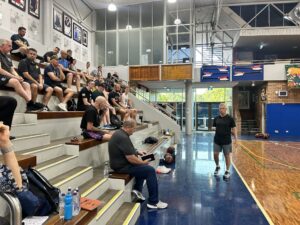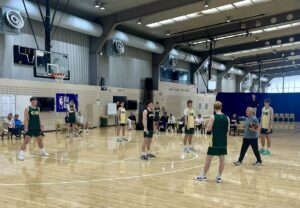Internationally respected coach Mike Dunlap recently visited Australia to conduct a series of clinics and professional development workshops for coaches in Sydney, Canberra and Melbourne.
One of the great minds in the international game, Coach Dunlap presented clinics in the three cities, as well as meting with high performance coaches from Basketball NSW, Basketball ACT, Basketball Victoria and the BA Centre of Excellence.
Here are some notes and takeaways from some of these sessions. Video of the three major clinics will be available soon.
Clinic at Pymble Ladies College (Sydney) –
- The process of improvement – bit like cooking a great meal
- Reduction
- A level of friction
- Heat
- Important to “guard your energy” as a coach – be aware of consistency of your energy as a leader
- “Don’t ever leave the fun behind” – ensure the environment is positive and there is an element of joy
- “When you lose a practice, you’ll lose a game”
- Strike a balance of blending a joy into the competition
- “Attitude reflects leadership”
- Book reference – “The Miracle Morning” – SAVERS
- Silence
- Affirmation
- Visualisation
- Exercise
- Reading
- Scribing

- 5 laws of learning
- Explain what you want
- Demonstrate for the learner
- Player demonstrates
- Correct demonstration
- Repetition is lord and master
- “Communication is habit”
- Concept of “setting the concrete” of learning
- Go slow
- Follow the steps
- Follow the process and preparation
- Don’t skip steps
- What is offence? – move and counter
- 5 ingredients of a drill
- Time
- Score – use “short scores” to build competition
- Rotation
- Teach to advantage
- Communication
- Avoid interrupting the drill
- Drill – “Cut Throat”
- 4 v 0 to start
- Sprint to position
- Start pass, cut and replace – no dribble
- Eyes to the rim on every catch
- Every basket cut through the charge halo – detail
- “Point the passer” – acknowledge the assist
- Build to 4 v 4 no dribble – same rules
- Add variance to the drill – limit dribbles for two of the four players on offence
- In the full court, no dribble – work on press attack and counters for pressure
- Concept of “praise, prompt and leave” – teaching method
- “Teach it simply and slowly”
- Use “I am sheets” to get to know your players and understand their world
- Have players write down five things about themselves (non-basketball) to provide some insights
- Have coaches do the same – vulnerability
- Use of “shadow teaching”
- Detailed, individual instruction
- Great way to teach dealing with physicality
- Show technique without the ball
TA’s from @CoachMikeDunlap clinic in Sydney
“Guard your energy” as a coach
Attitude reflects leadership
Praise, prompt, leave – teaching efficiency
Concept of “I am sheets” to get to know players
Learning – “attack what makes you uncomfortable”
Concept of “mentor committee” pic.twitter.com/GjVaaLn6g3— Peter Lonergan (@lono610) March 13, 2024
- Reading/learning
- “Attack what makes you uncomfortable”
- Step outside your comfort zone with the topics your read and research
- “Be on the hunt for field studies” – opportunity to learn from other environments, see how other coaches/teachers operate
- Value of spending time observing teachers in the classroom setting – how they instruct, teach and communicate
- Have a “critical friend” – “The person who will tell you that you have spinach in your teeth”
- Concept of a “mentor committee” – have a group of people of different ages and experiences to provide advice
- Self-awareness – ask 10 people in your environment if they feel you bring positive or negative energy
- Be a better delegator
- Don’t be a complainer
- How do players learn – be aware and adaptive to different styles of learning within the group
- Visual
- Auditory
- Kinetic
- Writing/Drawing
- Player as coach – peer to peer
- Cooperative versus competitive technique
- Whole, part, whole versus part whole method
- Providing feedback
- Do it in a neutral environment – not your office
- Feedback and check-ins over a meal – players love food!
- Go to areas of comfort first
- Coach Tim Grgurich – master coach, importance of physical touch in the teaching, high energy, consistent check-ins
- Priorities as a coach – “the power of NO”
- Guard your energy
- Importance of work-life balance
Workshop and Clinic at Basketball Australia Centre of Excellence (Canberra)
- Developing training habits
- Charles Brassard – principles in Co-operative learning
- Importance of metrics – measure what you want and value
- Jon Gordon “The Energy Bus” – move on one person to a different seat on the bus to change behaviour
- Concept of “Pods” – build pods to create measurable competition in practice
- Have metrics on the 50/50 ball – great way to measure competition and reward effort
- Use of personal records (PRs) is huge in building habits
- Analytics – “use of the analytics to drive the opinion”
- “Being more stoic in your approach allows you to see the game in real time”
- “Sometimes the best practice is no practice”
The final clinic of @CoachMikeDunlap visit to Australia and coaches from @Basketball_Vic have turned out in force at Mullum Mullum! 160-plus in the building to listen to the master coach. pic.twitter.com/vS5MrKVroF
— Basketball Australia Coaches (@BBALLAU_Coaches) March 18, 2024
- Use of imagery is powerful in learning and engagement – Mikel Atreta Arsenal FC
- Images and pictures are important for performance
- Use images in the training and competition environment
- Connect your words and themes with images
- “One person with courage is a majority” – seek input from your players
- Practice – “You are how you start”
- Building the ability to handle physicality
- Use of “shadow” drills
- Teach the technique without the ball
- “Players feel your energy” – Coach Tim Grgurich
- When you lose, its usually about one of two things
- Always keep your mind on what wins in the last two minutes – example, boxing out
- Pick and roll – Lawrence Frank
- Physical contact on ball screens still important
- Importance of set-ups by handler
- “Good point guards are ‘second hitters’ – use the screen, initiate contact, second move/decision
- Kelvin Sampson – 10 minute scrimmage with “capped” rims – rebound effort and contest, boxing out
- “Everything in basketball teaching is about ‘chunking’, focus on one thing at a time”
- Analytics – “figures lie and liars figure”
- Use analytics, but don’t ignore what you see in the coach’s eye
- Study players and see what their strengths are – be guided by your talent and personnel
- Two categories in successful coaching
- The things you are doing
- The “who’s” – personnel

- “We is the pass, I is the dribble” – importance of passing and cutting
- “If your players don’t go ‘through the fire’, you can’t get an outcome” – importance of competition and intensity in practice
- “You’re not going to be running for governor if you are a tough and demanding coach” – importance of creating a competitive and demanding practice environment
- Teaching timing on offence – “Knowing your why is crucial, but it is important to constantly teach the when”
- What is your “mistake recovery system (MRS)” – how do you help players move onto to the next task?
- “The quicker you acknowledge a mistake, the quicker you can move away from it”
- “Be on the prowl for good” – balance of correction and praise
- Importance of “filling the cup of self-esteem” with players
- “Ugly is beautiful, be ok with the mess”
- “You are your eyes, you are your questions”
Thanks to Basketball NSW, Basketball ACT, the Basketball Australia Centre of Excellence and Basketball Victoria for their generous support of Coach Dunlap’s visit.




Leave a Reply